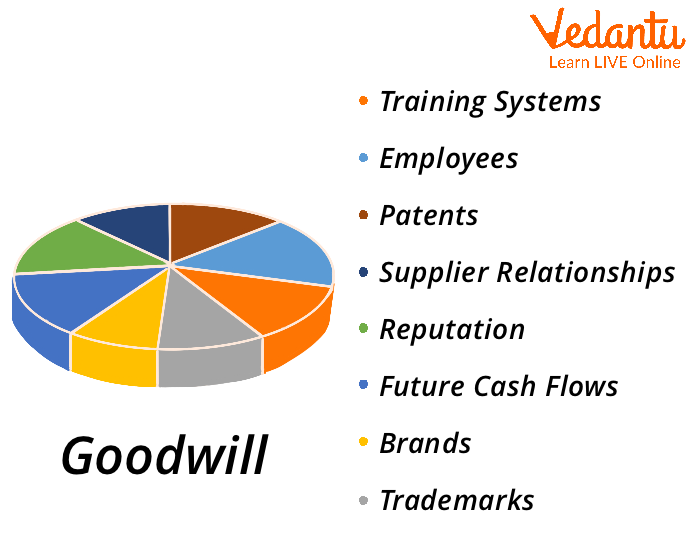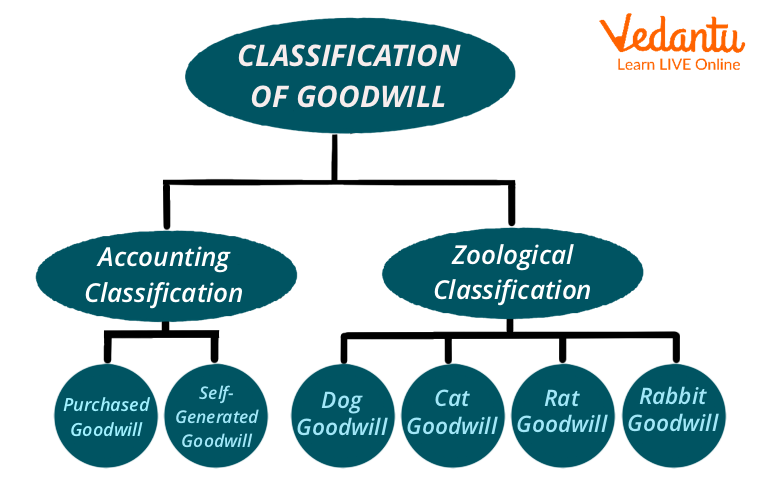




What are the Types of Goodwill?
Goodwill consists of a business's benefits to its customers, employees, and third parties. It is considered an attractive force that brings in customers. It strengthens the business's financial position to survive the competition and strategically sustains market leadership. Moreover, goodwill also opens new avenues and creates new opportunities for the business.
It represents a non-physical value over and above the physical assets. The value of goodwill is based upon the subjective judgement of the valuer.

Goodwill
Goodwill Definition
Goodwill is an intangible asset combined with various business ingredients - competent management, customer satisfaction, a favourable location, a profitable product, an outstanding reputation in the market, and the expectation that these ingredients will produce an above-normal rate of return for a long period.
Classification of Goodwill

Classification of Goodwill
Goodwill is of two types:
Purchased Goodwill - This type of goodwill arises when another business enterprise acquires a business enterprise, and the price paid is more than the net assets acquired.
Non-purchased Goodwill - This arises when a business generates its goodwill over time due to factors like location, good management, quality products, and good sales policies.
According to P. D Leake, goodwill is also classified as:
Dog Goodwill - Dogs are loyal and faithful. In this type of goodwill, customers are more attached to the persons conducting the business rather than the place of the business.
Cat Goodwill - This type of goodwill is considered best. In cat goodwill, the customers are loyal to the brand or the organisation. The persons who conduct business don’t concern them.
Rat Goodwill - In this type of goodwill, customers are not attached to a person or place and are casual in their behaviour. This is also known as fugitive goodwill.
Rabbit Goodwill - In this type of goodwill, customers will buy the product if it is available in their acceptable radius. They are more concerned about the nearness of the place.
What has Purchased Goodwill?
Purchased goodwill is the difference between the value paid for a business enterprise and the sum of its total assets less the sum of its total liabilities. Such goodwill is recognised and is shown in the Balance Sheet.
Features of Purchased Goodwill
It arises only from the purchase of the business.
Its cost could depend on future maintainable profits.
Factors such as market reputation, economies of scale, and fiscal advantages contribute to the value of goodwill.
What Is Self-Generated Goodwill?
Self-generated goodwill is the business's value over its net assets' fair value. This is also known as raised or inherited goodwill. This type of goodwill is not shown in the Balance Sheet.
Features of Self-generated Goodwill
It is internally generated.
No cost can be placed on it.
The value is based on the subjective judgement of the valuer.
Circumstances for Valuation of Goodwill
The following are the situations when goodwill is valued:
In the case of a sole trader, when the business is sold or a new person is admitted to the firm, the firm becomes a partnership firm.
In the case of a partnership firm, when there is a change in the profit-sharing ratio on admission, death, and retirement of a partner.
In the case of a joint stock company, the need for valuation may arise in the following cases:
When the company's business is sold to another company or when the company is amalgamated with another company
When the company has previously written off goodwill and wants to write it back in the books
When the stock exchange quotations are unavailable, shares must be valued for taxation purposes
Conclusion
In a nutshell, goodwill is described as momentum or a push that keeps the business going without further effort. It helps a business enterprise to earn greater profits than the returns normally to be expected on the capital represented by the net tangible assets employed in the business. It is the most unrealisable form of the asset as it can be disposed of only in the event of the business being sold.
FAQs on Goodwill: Meaning and Valuation
1. What are some factors affecting the goodwill of the business?
The following are some factors that affect goodwill :
Location: The location factor plays an important role in attracting various customers. If a business is located in a prominent place, it can increase the turnover of the business.
Quality of Goods: Quality plays an important role for the customers. If the quality of the products offered by the firm is up to the mark, it can generate better returns and customer satisfaction.
Efficient Management: Efficient management can help a business to earn more profits by successfully implementing various policies regarding the business.
2. What is hidden goodwill in a partnership firm, and how is it treated?
Sometimes, the value of goodwill is not given at the time of admission of a new partner. In that case, the goodwill is calculated with the help of the firm's total capital and the profit-sharing ratio among the partners.
To calculate the value of hidden goodwill, the following steps must be taken:
Step 1 - Calculate the total capital of the firm based on the capital brought by the new partner.
Total capital of the firm = New partner’s capital x Reciprocal of new partner’s share.
Step 2 - Calculate the combined capital of all partners, including the new partner's capital.
Step 3 - Hidden Goodwill = Total capital of the firm - Combined capital of all the partners.
3. What are the methods for the valuation of goodwill?
The following are methods for calculating goodwill:
Average Profit Method - Under this method, goodwill is calculated based on average profits of the past years.
Goodwill = Average profit x No. of years purchase
Average profit = Total profit of past years/ Total no. of years
Super Profit Method - Under this method, goodwill is calculated based on excess profit earned by the firm over normal profit earned by similar firms in the industry.
Goodwill = Super profit x No. of years purchase
Super profit = Average profit - Normal profit
Capitalisation Method - Under this method, goodwill is the difference between the capital required to earn the current rate of profit and the net assets employed in the business.





















